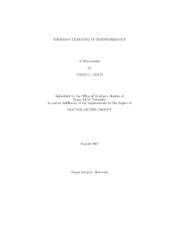| dc.description.abstract | Life sciences research is advancing in breadth and scope, affecting many areas of life
including medical care and government policy. The field of Bioinformatics, in particular,
is growing very rapidly with the help of computer science, statistics, applied
mathematics, and engineering. New high-throughput technologies are making it possible
to measure genomic variation across phenotypes in organisms at costs that were
once inconceivable. In conjunction, and partly as a consequence, massive amounts
of information about the genomes of many organisms are becoming accessible in the
public domain. Some of the important and exciting questions in the post-genomics
era are how to integrate all of the information available from diverse sources.
Learning in complex systems biology requires that information be shared in a natural
and interpretable way, to integrate knowledge and data. The statistical sciences can
support the advancement of learning in Bioinformatics in many ways, not the least
of which is by developing methodologies that can support the synchronization of efforts
across sciences, offering real-time learning tools that can be shared across many
fields from basic science to the clinical applications. This research is an introduction
to several current research problems in Bioinformatics that addresses integration
of information, and discusses statistical methodologies from the Bayesian school of
thought that may be applied. Bayesian statistical methodologies are proposed to integrate biological knowledge and
improve statistical inference for three relevant Bioinformatics applications: gene expression
arrays, BAC and aCGH arrays, and real-time gene expression experiments.
A unified Bayesian model is proposed to perform detection of genes and gene classes,
defined from historical pathways, with gene expression arrays. A novel Bayesian statistical
method is proposed to infer chromosomal copy number aberrations in clinical
populations with BAC or aCGH experiments. A theoretical model is proposed, motivated
from historical work in mathematical biology, for inference with real-time gene
expression experiments, and fit with Bayesian methods. Simulation and case studies
show that Bayesian methodologies show great promise to improve the way we learn
with high-throughput Bioinformatics experiments. | en |


